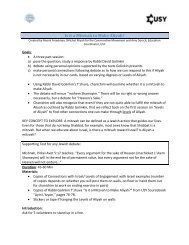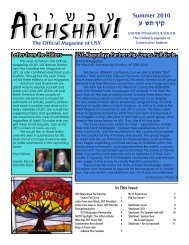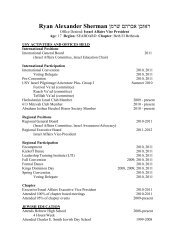Written and Compiled by Amy Dorsch - United Synagogue Youth
Written and Compiled by Amy Dorsch - United Synagogue Youth
Written and Compiled by Amy Dorsch - United Synagogue Youth
Create successful ePaper yourself
Turn your PDF publications into a flip-book with our unique Google optimized e-Paper software.
הדרכה למדריכים<br />
A H<strong>and</strong>book for the <strong>Synagogue</strong> <strong>Youth</strong> Advisor/<strong>Youth</strong><br />
Director<br />
<strong>Written</strong> <strong>and</strong> <strong>Compiled</strong> <strong>by</strong> <strong>Amy</strong> <strong>Dorsch</strong><br />
With Contributions <strong>by</strong> Arlyne Bochnek, Regional <strong>Youth</strong> Director, CRUSY USY<br />
Chapter XIII:<br />
Working with <strong>Synagogue</strong> Clergy <strong>and</strong> the <strong>Youth</strong><br />
Commission<br />
Includes fundraising <strong>and</strong> budgeting
Chapters to Help Your Chapter: Table of Contents<br />
Click on other “chapters” in this series for information on the following topics:<br />
Chapter I: Introduction<br />
• USY <strong>and</strong> Kadima 101- vocabulary, goals, mission, structure, summer programs,<br />
clubs, etc., the USY Tikun Olam Program in brief<br />
Chapter II: The Role of the Advisor<br />
• What does an advisor do, being a dugma/role model, st<strong>and</strong>ards<br />
Chapter III: Starting a Chapter From Scratch/Reinvigorating a chapter<br />
Chapter IV: Programming Basics: Basic planning guide, sample program assessment,<br />
planning inter-chapters programming, general tips<br />
Chapter V: Adding Jewish content to social programs<br />
Chapter VI: Social issues of teens from a Jewish perspective<br />
Chapter VII: Kadima<br />
• What is a "tween" or “pre-teen,” <strong>and</strong> how do our programs differ for this cohort<br />
(includes program ideas)<br />
Chapter VIII: Marketing to young people<br />
• Includes general publicity tips <strong>and</strong> techniques<br />
Chapter IX: Partnership with Formal Educational Institutions (Congregational <strong>and</strong> Day<br />
Schools)<br />
Chapter X: Using technology<br />
• Technology defined, general uses<br />
Chapter XI: Rules, Regulations <strong>and</strong> Policies<br />
• Kashrut, Dress, Code of Conduct<br />
Chapter XII: Working with a USY Leadership Board<br />
• Tips, leadership training <strong>and</strong> board bonding activities<br />
Chapter XIII: Working with <strong>Synagogue</strong> Clergy <strong>and</strong> the <strong>Youth</strong> Commission<br />
• Includes fundraising <strong>and</strong> budgeting<br />
Appendices: Regional contact information, Resources <strong>and</strong> forms, where to go for what<br />
you need<br />
• JYDA membership information (p.69), Guide to Leading a Discussion (p.70-74),<br />
sample Sicha/Limud outline (p.75-80), Service Outline (p.81-93, compiled <strong>by</strong> Todd<br />
Yellin, adapted <strong>by</strong> Ari Yares).<br />
613 Mitzvah Corps application, Heschel Honor Society application, Hechalutzim<br />
application, list of free publicity materials all available on the USY website.<br />
USY would like to acknowledge the following people for their reader reviews <strong>and</strong> comments:<br />
Lynn Berk, <strong>Youth</strong> Director, Tikvat Israel, Seabord Region USY<br />
Michelle Rich, Director of Education <strong>and</strong> <strong>Youth</strong> Activities, Hagalil Region USY<br />
Arlyne Bochnek, Regional <strong>Youth</strong> Director, CRUSY Region USY<br />
Sheri Knauth, <strong>Youth</strong> Director, Beth Israel, Seaboard Region USY
Chapter XIII: Working with the <strong>Synagogue</strong> Clergy<br />
Working with the <strong>Youth</strong> Committee<br />
The synagogue youth committee is usually your best advocates <strong>and</strong> strongest<br />
supporters. It can be comprised of synagogue members <strong>and</strong> clergy who oversee the<br />
youth activities of the synagogue. They are likely a dedicated group of lay leaders who<br />
have the leadership training <strong>and</strong> youth involvement at the forefront of their priorities.<br />
They should be there to help you in your efforts <strong>and</strong> help you problem solve.<br />
People who may sit on this committee include:<br />
• <strong>Synagogue</strong> youth director (or any professional assigned to the youth program<br />
such as an Education Director)<br />
• involved parents,<br />
• clergy<br />
• synagogue president, the chapter president<br />
Function of the Committee:<br />
• hire the youth advisor<br />
• prepare <strong>and</strong> oversee the youth activities budget<br />
• fundraise on behalf of youth activities<br />
• formulate youth related policies<br />
• h<strong>and</strong>le any legal issues that may arise<br />
• provide assistance <strong>and</strong> support for youth advisor during the year<br />
Reporting on <strong>Youth</strong> Activities: You may be asked to give a report at youth committee<br />
meetings. Try <strong>and</strong> be as honest possible with your analyses. They cannot help you if<br />
everything is going just perfectly but also will doubt your abilities <strong>and</strong> motivation if you<br />
sound like there is no hope. Try <strong>and</strong> pinpoint specific challenges <strong>and</strong> ask for specific<br />
areas of assistance.<br />
For example, instead of saying “everything’s a mess. I wish it was the way it used to be,<br />
no one shows up to anything,” try focusing on specific challenges. Use sentences such as<br />
“attendance at programs has been low. I’m concerned that our marketing techniques are<br />
not reaching potential members. I could use your help <strong>by</strong> reaching out to other parents of<br />
Kadima aged kids or making other suggestions for improvement.” You want to share your<br />
concerns without sounding flustered or discouraged <strong>and</strong> be honest with your requests<br />
for assistance <strong>and</strong> input.<br />
Build on common concerns: Remember, you’re all on the same team. It may sometimes<br />
be difficult to remember this, but keep in mind that you all share common concerns <strong>and</strong> a<br />
common mission. Always keep in mind the position of your youth commission members<br />
(many of which are parents of USYer or Kadimaniks first <strong>and</strong> foremost), <strong>and</strong> maintain<br />
your patience <strong>and</strong> professionalism.<br />
Working with difficult people:<br />
Try your best to maintain a positive <strong>and</strong> professional demeanor, even when dealing with<br />
the most challenging personality types. Practice good listening <strong>and</strong> empathy, try <strong>and</strong><br />
underst<strong>and</strong> the source behind their behavior,<br />
Effective types of speech to use when dealing with difficult personality types:<br />
• Use of “I” statements: “I can see what you’re saying,” “I feel or sense that…”<br />
• Paraphrase- Let me clarify so I can make sure I underst<strong>and</strong> you…<br />
• Reflect on feelings- I can sense that you’re apprehensive about this upcoming<br />
program. What concerns do you envision
• Ask open ended questions- “please share your ideas for dealing with our<br />
noticeable senior drop off this year”<br />
• Keep in mind that they are often not attacking you, rather the situation.<br />
• Offer options <strong>and</strong> alternatives- “I see that you’re not comfortable with _________,<br />
would ________ work better<br />
• Can we work together to come up with __________<br />
• Can I get your support with _________<br />
• Direct comments toward the issue at h<strong>and</strong>, not at specific people<br />
• Keep your focus on attacking the problem, not the person<br />
Top Tips for Working with Clergy<br />
• Set up an initial meeting with the clergy in your synagogue <strong>and</strong> ask him/her where<br />
he/she may envision involvement with the youth program (if at all).<br />
• Share your calendar with them <strong>and</strong> ask if he/she would like to be part of anything<br />
specific: “can we count on your to lead a session at our Shabbaton Are you<br />
available to give a D'var Torah or teach a quick drash at any of the Shabbat dinners<br />
we have planned Can you announce upcoming Kadima programs from the Bima<br />
each Shabbat when there are big crowds of B’nai Mitzvah kids Can we give B’nai<br />
Mitzvah free membership to Kadima Do you have discretionary funding for youth<br />
scholarships or to subsidize programming Can you write an article about the youth<br />
program in a synagogue newsletter”<br />
• Keep the rabbi or cantor involved in the chapter programming <strong>by</strong> adding him/her to<br />
USY listservs, sending all him/her all flyers <strong>and</strong> reporting in every once in a while<br />
when you’re at the synagogue.<br />
• Ask the rabbi or cantor if the Kadimaniks or USYers can be involved at all in<br />
synagogue programming- services, learning, community programs, etc.<br />
• Underst<strong>and</strong> that each clergy person has his/her own priorities. If you find that the<br />
rabbi does not seem to support you, underst<strong>and</strong> the he/she has a lot on his/her<br />
plate. Try offering youth support within the synagogue <strong>and</strong> hopefully, he/she will<br />
return the support.<br />
Top Tips for Budgeting:<br />
List all budget items on a spreadsheet <strong>and</strong> be sure to overestimate costs (pad your<br />
budget).<br />
If you are charging for the program to offset costs, under-estimate attendance. It is<br />
better to end up with over flow than to not meet your budget<br />
Get your non-perishable in bulk or at a discount store. Always buy the generic<br />
br<strong>and</strong>s of snacks if they are hechshered<br />
If you are inviting a guest, ask them if they would be willing to donate their services<br />
or seriously negotiate a fee. Offer an honorarium as a fee.<br />
Consider hidden costs such as special foods for dietary restrictions <strong>and</strong> paper<br />
goods<br />
Count backwards- start with a set amount <strong>and</strong> make sure you can cover all your<br />
costs without going over the set amount you had allocated<br />
See below for working with your youth commission to fund youth program

















